Whether home workouts are great because they fit your weekly schedule, your preferences, or your personal goals over the weight room, getting a sweat-inducing, body-toning workout in the convenience of your own home without a personal trainer is a great way to get fit and stay fit – no matter your fitness goals.

The problem most people have is trouble adjusting their fitness program, designed for the gym, to fit an at home workout split situation, without lifting weights or only lighter weights and less equipment. Don’t sweat it, we’ve got you covered.
For years, I’ve improved and maintained speed, strength, muscle, and stamina at home and on the road without a gym and with minimal equipment – whether traveling around the world or living in an austere desert on a military deployment. In this article, I’ll share the best exercises, workouts, and overall program for an at home workout split to help you achieve and maintain your fitness goals.

This article contains affiliate links
Continue reading to learn everything you need to know to pick the right training split for your home workout program, or click below to jump right to the best at home workout split options.
- 3-day split for cardio health and general fitness (HIIT and Crossfit at home)
- 3-day split for building muscle and strength
- 3-day split using bodyweight training and calisthenics for strength and lean muscle mass
- 4-day split for functional strength and general fitness
- 5-day split for muscle growth and strength – High Intensity
- 6-day Split for strength and muscle mass
- 7-day Calisthenics split for strength and muscle
- 7-day split for functional fitness and fat loss
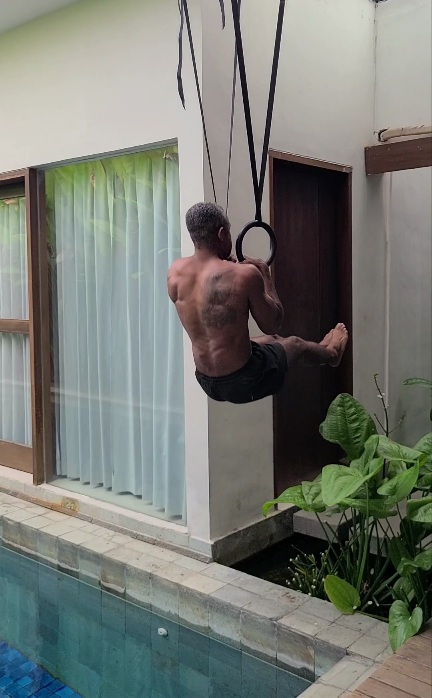

Table of Contents
- 4 Considerations for your at home workout program: Essential variables in your fitness program
- The Basics of a good at home workout split: ” Push pull legs cardio core”
- What is the best way to split your fitness program: Upper-body days + lower-body days day or entire body every day
- The Best at Home Workout Split Options, by Goal
- 3-day split (cardio health and general fitness) (HIIT and Crossfit at home)
- 3-day split (Building muscle with dumbbells and resistance bands)
- 3-day split (Body weight training for strength and lean muscle mass)
- 4-day split (Functional strength and General Fitness)
- 5-day split (Muscle growth and strength – High Intensity)
- 6-day Split for Strength and Muscle Mass
- 7-day split for functional fitness and fat loss
- Where to find the Day’s Workout for HIIT Days or New Workouts
- Planning Rest Days and Recovery Time the Right Way
- The Essential Equipment for Your Home Gym, and the Gear We Recommend
- FAQs

Why workouts at home are my favorite option: Fits my schedule, gets the gains, and are possible wherever I’m at
“Make time for fitness or make time for sickness,” is a motto that’s part of the way I live. The better your health and fitness level, the longer, happier, and more fulfilling life you will live – mobile, capable, and resistant to disease.
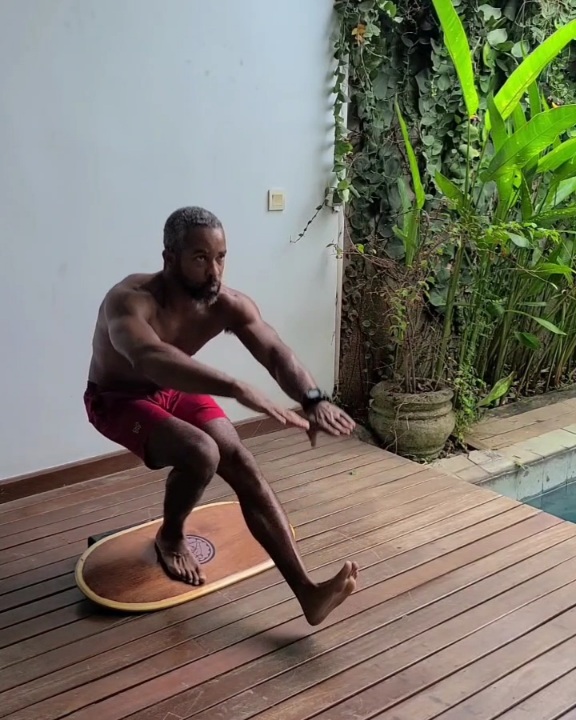
With such high stakes, not having time to go to the gym shouldn’t be an excuse for skipping a workout – and precisely what makes home workouts so powerful and valuable.
However, a second barrier for many people is not knowing how to work out in a home gym that is less well-equipped than your average gym. How can we create the necessary fat-burning, muscle-building intensity with just a few key pieces of equipment at home?
The answer is:
- By planning an at home workout split for resistance that creates the right muscle stimulating intensity by focusing on compound movements, not isolation exercises
- By using calisthenics and bodyweight exercise progressions to create the same muscle mass building intensity that we aim for with weights, but with minimal equipment
- By strategically purchasing specific equipment (dumbbell, kettlebell, sandbag) that is versatile and can be used to create adequate resistance for muscle growth, strength improvements, and fat loss
- By supplementing with compact, minimalist, versatile exercise gear (resistance bands, suspension trainers, gymnastics rings) for additional resistance
Each of these approaches is a potential tool we can take, adjust, and piece together into a home workout program that can be done with minimal equipment for effective strength building, muscle building, and fat burning at home, or anywhere.
Following an at-home workout split program is a great way to achieve great results because it reduces the complexity in achieving fitness goals at home – just follow the plan
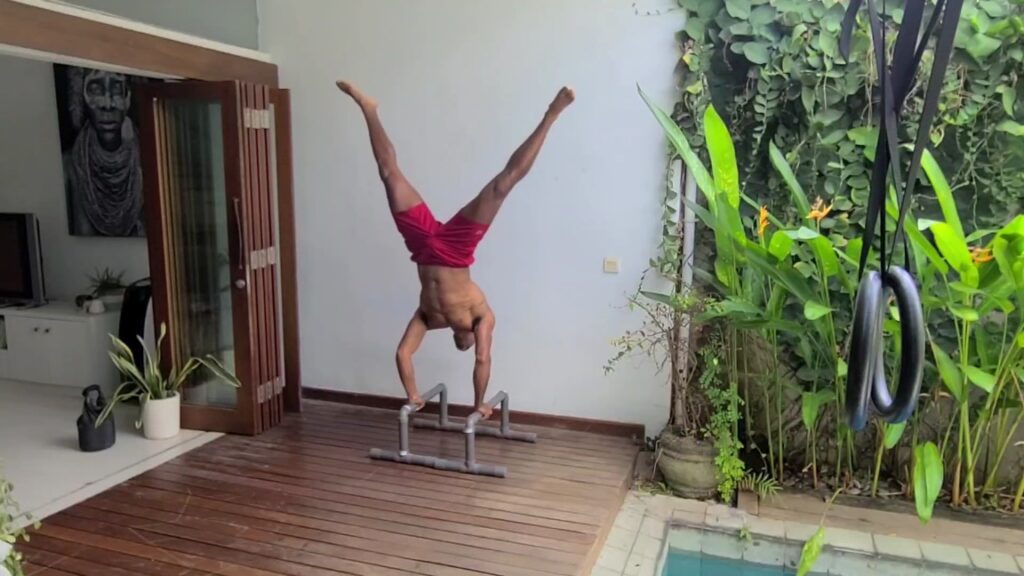
Using a workout split and overall program designed to 1) fit your schedule 2) lead to your goals and 3) fit the equipment you have available is an excellent way to ensure you stay on track with your fitness routine, with minimal motivation required.
Having specific movements and exercises planned into each 3, 4, 5, 6, or 7 cycle and subsequent rest days ensures balanced stimulation for growth, and recovery time to maximize performance gains, muscle gains, and fat loss without any further though
In short, a good workout split tailored to you and your home gym equipment is an easy to follow recipe for your fitness success.
Considerations for your at home workout program
Deciding the best training split for you should take into account four essential variables in your life.
- What equipment do you have available: Body weight only, dumbbells, kettlebells, barbells, rungs, etc.
- What are your Fitness Goals: Weight loss, strength gains, muscle gain, or just stay fit?
- Schedule: How many days do you have available to train?
- Experience and conditioning level: Are you newly returning to fitness, and will simple exercises suffice? Or are you at an advanced level requiring a very strategic fitness program, to progress?
Click here to return to the Table of Contents

What equipment do you have available: Body weight only, dumbbells, kettlebells, barbells, rungs, etc.
To get fit in line with any fitness goal all you have to do is 1) push and pull against resistance (for strength and muscle), 2) stay moving at low intensity for an extended period, for cardio training and additional fat loss, and 3) rest properly. That’s it.
To make the first two requirements possible at home – pushing or pulling against resistance and keeping moving – you will need a few tools.
Here are the best and cheapest options for fitness equipment by category. Just ensure you have at least one tool from each category to work the pulling muscles (group A below), one to work the pushing muscles (group B below), and one to keep moving at low intensity (group C below). Additional options are 1 piece of equipment for cardio (Group D) and calisthenics equipment (Group E)
Group A: All in One Equipment (Allows all pushing exercises, pulling exercises, and cardio)
– Suspension Trainers: Either a TRX GO, a Pocket Monkii, or this DIY Suspension Trainer
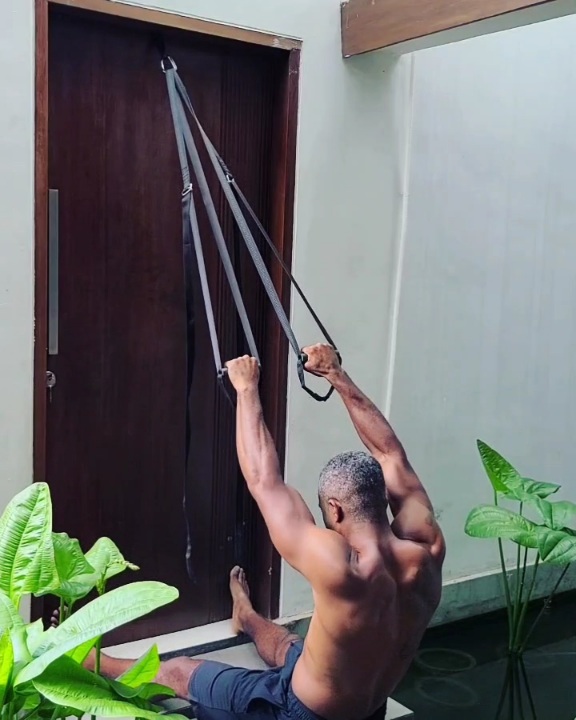
Group B. Pushing, Squatting, and Deadlifting equipment for home gyms (Bench Press, Overhead Press, Clean, High Pull, Rows, Deadlifts)
– Dumbbells: Ideally adjustable dumbbells like these
– Kettlebells: For the average make, a 20lb to 25lb dumbbell and a 40lb to 55lb will suffice, and a 10lb to 15lb Kettlebell along with a 25lb to 35lb kettlebell for women. I recommend these Rogue fitness kettlebells as they are what I use at home and trust
– Sandbag with handles: These GORUCK sandbags with handles are my go-to, and perform like a barbell. There are plenty of other great sandbags, and these sandbag workouts show how versatile a tool these can be
– Sandbag Kettlebell: A great, travel friendly option, I recommend the GORUCK sand kettlebell foremost and the Meister sand kettlebell as a close second
– Resistance Bands: Rogue Monster Bands are the best bands for hard training, but these other great resistance bands are awesome options too.
– Ruck Sack with weight: A simple but tough backpack with weight is an excellent workout tool. I recommend the GORUCK packs, but these other great rucks will do just as well.
– Suspension Trainers: Either a TRX GO, a Pocket Monkii, or this DIY Suspension Trainer

Group C. Pulling exercise equipment for home gyms (Pull Ups, Horizonal Rows, High Pulls)
- – Pull Up Bar
- – Gymnastics Rings
- – Suspension Trainer
- – Resistance Bands
Group D. Cardio training equipment for home gyms
- – Jump Rope
- – Light Kettlebell
- – Bodyweight

Group E. Calisthenics Equipment
- – Parallettes
- – Gymnastics rings or suspension trainer
- – Sliders
- – Yoga Blocks
- – Weight Vest
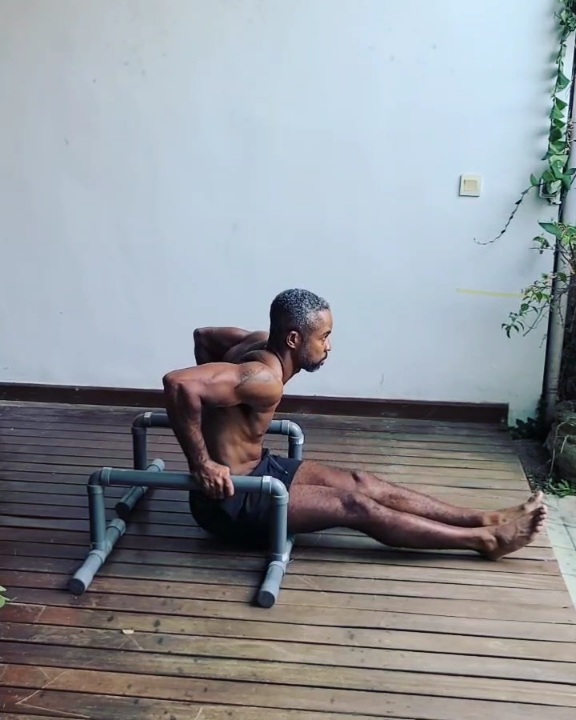
Once you have at least one item from each group, you have a fully equipped home gym. Then, it’s time to plan your workouts and weekly schedule. Your workout split planning should include the different days for workouts, your rest day, target muscle groups and movements for training days, and time for mobilization and active recovery.
However, in order to plan a good fitness plan, you need to first decide what goal you are working towards.
Click here to return to the Table of Contents

What are your Fitness Goals: Weight loss, strength gains, muscle gain, or just staying fit?
Every exercise and workout you do should intentionally lead to your fitness goal – whether that goal is to just stay healthy or to add some muscle to target areas of your body.
In fitness training, and especially in situations of limited equipment or time, it is best to prioritize a single fitness goal at a time. Once you’ve achieved your primary fitness goal, continue training to keep your newly found success, and then adjust training to add a new fitness goal or success.
The main fitness goals you’ll need to decide between are:
- Muscle growth and build strength
- Fat loss
- Cardiovascular health, stamina, and endurance
- Mobility
- General fitness
For Muscle growth or strength
Aim for a 3-day split that prioritizes high-intensity exercises, and works each movement pattern and major muscle group once to twice weekly, with 48 hours of rest per muscle group. Rest days between each 3-day split should number 1 to 2 days rest – listening to your body and erring on the side of more rest.
With strength comes muscle and with muscle comes strength, so training for either will produce considerable gains in the other.
For at home workouts, targeting strength and muscle growth, consider using the following tools
- Upper Body Pulling muscles and movements: Gymnastics rings, suspension trainer, pull-up bar, or resistance bands**
- Upper Body Pushing muscles: Sandbag with handles, kettlebells, dumbbells, barbell + bumper plates, resistance bands
- Legs: Sandbag, dumbbells, kettlebells, barbell + bumper plates, resistance bands.
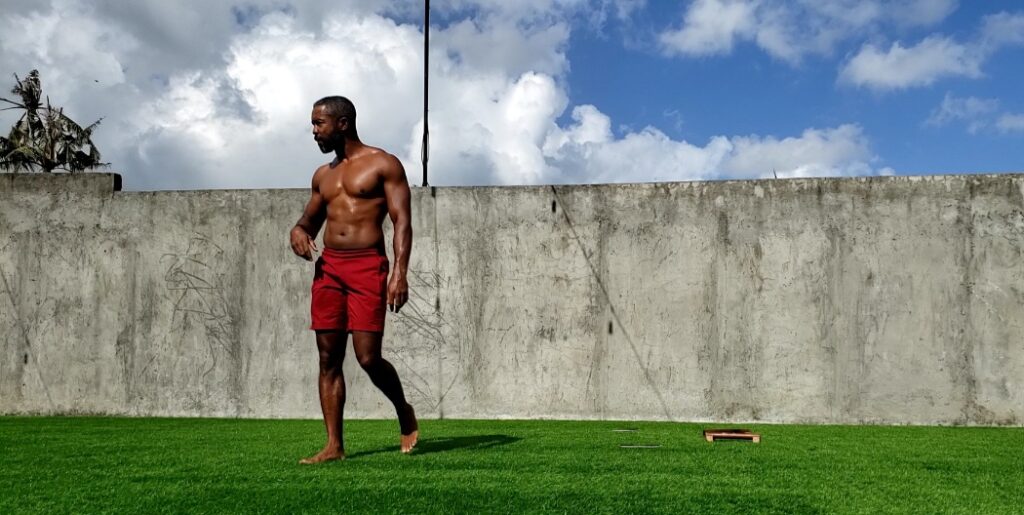
For Fat loss
For fat loss, aim for higher volume and lower intensity exercises performed on a 4 to 6-day split with 1 day to 2 days rest at the end of a workout split.
Additionally include a resistance component in each workout because **research has shown resistance workouts continue burning fat and calories 24 to 48 hours after a workout, and longer than steady state cardio like running or rowing.
(Source: NIH)
For Cardiovascular health, stamina, muscular endurance, and general Fitness
For cardiovascular health, stamina, and muscular endurance, multi-modal High-Intensity Interval Training (HIIT) performed on a 2 days exercising and 1 day of rest split is the most effective approach.
To train for cardiovascular and metabolic conditioning, workouts should keep the heart rate up the entire time within the training zone, aiming for 30 minutes 60 minutes per training session.
To calculate the training zone, first calculate your maximum heart rate in beats per minute (BPM), which is [220 beats per minute – Your Age]
So, at age 38, my maximum heart rate is 182 (220-38 = 182)
Next, calculate your target training zone
– Moderate intensity activity is 64% to 76% of your maximum heart rate
– Vigorous activity is 77% to 93%
So, for me, at 38 years old
Max heart Rate: 182 BPM
Moderate Intensity Exercise Heart Rate: 116 BPM to 138BPM
High-Intensity Exercise Heart Rate: 139 BPM to 169 BPM
(Source: CDC)
Constantly varied exercises and movements, similar to the common approach in Crossfit, are the best bets for achieving these goals and are thoroughly simple.
To target cardiovascular health, stamina, and muscular endurance at home, follow any of the workouts on these great at home HIIT workout lists
- Bodyweight Crossfit Workouts
- The Crossfit Benchmark Workouts
- Travel-friendly Crossfit Workouts
- Hotel Crossfit Workouts
- Crossfit Hero WODs
For Mobility and Joint Health
For recovery and for athletes aiming for full spectrum fitness, performance, and wellness, mobility is essential.
Mobility is the ability to move through a joint’s full, healthy range of motion pain-free, and being able to apply strength safely at any point in that range.
Mobility training is best performed in a 7-day split (in addition to resistance and cardio training), breaking mobility work into major muscle groups – shoulders and chest, back, hips, legs, etc. – to complete a full mobility training session in 20 minutes or less.
Mobility WOD and The Ready State, both projects by Kelly Starret, will be your best resources for daily mobility training.
Rest assured you can train mobility 7 days a week with no rest days and still experience benefits because all work is very low intensity and requires minimal recovery.
Click here to return to the Table of Contents

Schedule: How much time do you have available in your weekly schedule?
How many days do you have available to train? The number of days you have available to train, per week, should be your number 1 consideration when planning your workout split.
I recommended a minimum of 3 days of training per week, as this allows 1 day per week to train each major muscle group and movement, which is just above the bare minimum to maintain strength, muscle, and performance gains.
For high-intensity training, a maximum of 5 days of training in a week should be your average upper limit, with 2 rest days fully respected with stretching and nutrition.
For low-intensity training, 6 days per week with 1 day resting is the maximum you should consider, with 3 days per week being the minimum. For low-intensity training, I recommend aiming to achieve 75 to 150 minutes of exercise per week across all workouts, as recommended by the American Heart Association.

Experience and conditioning level
Are you newly returning to fitness, and will simple exercises suffice? Or are you at an advanced level requiring a very strategic fitness program, to progress?
For experienced athletes in top-notch condition now: 5 days of training per week is optimal, 4 is the minimum
If you’ve been training for a long period and want to maintain or improve your condition and performance, you will need to train more often than a newbie – think 4 intense days a week minimum, but respect the
For beginner athletes generally and for experienced athletes starting a new routine or after a long break, start slow, with low to medium intensity and ample rest.
Beginner athletes should start with workout routines exercising only 3 to 4 days per week at low intensity to moderate intensity, progressing in the number of training days when they feel their necessary recovery time shortening, and when they’re requiring more intensity to experience more strength and muscle gains.
Full-body workouts are the beginner athlete’s friend, as you will not require as much intensity and volume in the early stages of your fitness journey.
Click here to return to the Table of Contents

The Basics of a good at home workout split: ” Push pull legs cardio core”
Any good workout program, whether designed for working out in the gym or elsewhere, is built around the movements and training of “push pull legs cardio core.” Once the specific exercise movements for each are decided, such as bench press, dips, and overhead press for “push,” our work of planning is simply fitting the chosen exercise movements into your days available and deciding a rep scheme for the workout. First, let’s see what the movements include
Upper Body Movement Patterns
- Pushing: pushing down (dip), pushing forward (push-up or bench press), pushing up (overhead press or handstand pushup)
- Pulling: Pulling down (lat pull down or pull up), pulling from the front (horizontal row), pulling up from below (clean or high pull)
Lower Body Movement Patterns
- Hip extension: glute dominant leg movements (deadlift or good mornings)
- Leg extension: quad dominant leg moveemtns (squats, leg extensions)
- Calf flexion: calf raises, box jumps
- Leg flexion: hamstring dominant (hamstring curls)
Cardio Modes
Sustaining a heart rate in the “training zone” to condition the heart and cardiovascular system and metabolic Conditioning – to condition your bodies efficiency in the metabolic pathways, achieve by keeping our heart rate in the training zone.
Core Training
- Stability – maintaining a solid core, supporting the spine and healthy movement. Can be accomplished with planks or any movement variation that emphasizes an active core supporting a neutral spine
- Flexion: Any compression exercise, including V ups, core compressions, crunches, etc.
How we approach our split: Upper-body days + lower-body days day or entire body every day
If you are targeting muscle growth, or strength increases, a split that includes upper-body days and separate lower body training days is the best workout split approach. This approach will allow you to train with high intensity (maximum resistance) for a specific muscle group, while also giving a minimum 48 hour recovery period before hitting the same muscle group again.
If going with a “body part” split be sure to add one full day of rest after each rotation of cycling through body parts (upper body, lower body) and movements
If fat loss or general fitness is your goal, then working the entire body (as in working upper body movements and lower body movements) at a lower intensity (further from max resistance/weight) is a better approach.
Working the whole body at once with compound, full-body exercises, like burpees, low weight clean and presses, and many kettlebell movements will get your heart rate pumping more, burning more calories during the workout, while the resistance nature of moderate intensity compound movements will keep your metabolism.
Variations of the entire body approach include P90X, many Crossfit workouts, and standard HIIT workouts such as Tabata** or **“Fight Gone Bad”**
If going with the approach of training the entire body every workout, be sure to rest every 2 to 5 days for 1 to 2 days depending on your workout intensity level of the past workouts, and how often you’ve rested in the past few weeks and months.
Click here to return to the Table of Contents

The Best at Home Workout Splits and Workout Routines, By Goal

- 3-day split (cardio health and general fitness) (HIIT and Crossfit at home)
- 3-day split (Building muscle with dumbbells and resistance bands)
- 3-day split (Body weight training for strength and lean muscle mass)
- 4-day split (Functional strength and General Fitness)
- 5-day split (Muscle growth and strength – High Intensity)
- 6-day Split for Strength and Muscle Mass
- 7-day split for functional fitness and fat loss
Click here to return to the Table of Contents

3-day split (cardio health and general fitness) (HIIT and Crossfit at home)
- Day 1: Upper Body – perform pushing and pulling exercises in the vertical and horizontal planes
- Day 2: Lower Body – Perform exercises similar to the deadlift (hip extension) and squat (knee extension) exercises
- Day 3: HIIT and mobility – Train a HIIT workout for cardio and metabolic conditioning
- Day 4: Rest then repeat
3-day split (Building muscle with dumbbells and resistance bands)
- Day 1: Upper Body Pushing (all 3 planes): Train exercises pushing up (overhead press), pushing forward (push up / bench press), and pushing down (dips)
- Day 2: Upper Body Pulling (all 3 planes): Train exercises pulling down (pull up), pulling horizontally (horizontal row), and pulling up (high pull)
- Day 3: Hip / Leg Day: Train hip extension (deadlift, good mornings), leg extension (squat)
- Day 4: Rest then repeat
3-day split (Body weight training for strength and lean muscle mass)
- Day 1: Upper Body, Vertical Plane Push & Pull (3 movements): Muscle Up or Pull Up + Dip, Reverse Muscle Up (with light weight or resistance band) or Clean + Handstand Push-Up progression + 90 Degree Push Up Progression
- Day 2: Upper Body Horizontal Push & Pull: (2 movements) and core – Horizontal pulling (Horizontal row or Lever), horizontal pushing (Push Up or Planche progression)
- Day 3: Legs, hips, and core: Squatting (single leg squat), deadlifting (single leg glute bridge with sliders), core stability (planks) and core compression (V-Ups)
- – Rest
4-day split
- Day 1: Upper body pushing: Overhead Pushing (overhead press or handstand push-up progressions), horizontal pushing (bench press or push-ups), vertical downward pushing (dips, weighted dips
- Day 2: Legs strength: Squat (standard squat, single leg squat), deadlift (single leg deadlift or single glute and hamstring curl)
- Day 3: Upper pulling: Pulling downward (pull up), pulling horizontally (row), pulling upward (upright row)
- Day 4: Full body HIIT, with legs and muscular endurance focus: Work in exercises like the jump squat, box jump, and sprints or workouts from this list of Bodyweight HIIT workouts
- Day 5: Rest
5-day split for muscle growth and strength – High Intensity
- Day 1: Upper body pushing and pulling: Overhead Pushing (overhead press or handstand push-up progressions), horizontal pushing (bench press or push-ups), vertical downward pushing (dips, weighted dips, ulling downward (pull up), pulling horizontally (row), pulling upward (upright row)
- Day 2: Legs strength: Squat (standard squat, single leg squat), deadlift (single leg deadlift or single glute and hamstring curl)
- Day 3: Upper pulling: Upper body pushing and pulling: Overhead Pushing (overhead press or handstand push-up progressions), horizontal pushing (bench press or push-ups), vertical downward pushing (dips, weighted dips, ulling downward (pull up), pulling horizontally (row), pulling upward (upright row)
- Day 4: Legs strength: Squat (standard squat, single leg squat), deadlift (single leg deadlift or single glute and hamstring curl)
- Day 5: Core, Arms, Full body HIIT: Core stabilization (planks), core compression (V-ups), triceps extensions, and biceps biased curls. Crossfit style HIIT workouts (such as these Bodyweight or at home Crossfit workout) for cardio training and additional fat burning
- Day 6: Rest and Mobilize Upper Body: Mobilize shoulders, chest, arms, and back
- Day 7: Rest and Mobilize Lower Body: Mobilize hips, quads, hamstrings, and calves
6-day Split for Strength and Muscle Mass
- Day 1: Upper body push (overhead, forward, down): – Day 1: Upper body pushing: Overhead Pushing (overhead press or handstand push-up progressions), horizontal pushing (bench press or push-ups), vertical downward pushing (dips, weighted dips
- Day 2: Legs: Strength: Squat (standard squat, single leg squat), deadlift (single leg deadlift or single glute and hamstring curl)
- Day 3: Rest and mobility work (Lower body focus): Mobilize shoulders, chest, arms, and back
- Day 4: Upper Body, pull: Pulling downward (pull up), pulling horizontally (row), pulling upward (upright row)
- Day 5: Legs, Endurance, or Full Body HIIT: Choose a Crossfit style workout with emphasis on continuous movement and short rest or explosive medium intensity movements
- Day 6: Rest and mobility work (Upper Body focus): Mobilize hips, quads, hamstrings, and calves
7-Day Split for Calisthenics and Body Weight Training
Day 1:
- 90 Degree Push Up
- Bent Arm Planche
- Planche
- Handstand Holds
- Deficit Handstand Push Up
Day 2:
- Single Leg Romanian Deadlift
- Nordic Hamstring Curls
- Sissy Squats
- Pistols
- Lunges
Day3:
- Ring Muscle Up
- 1-Arm Pushup and Push Up variations
- V-sit + Core Work
- Human Flags
Day 4: Rest and Mobilize
- Hip Mobility Training
- Shoulder Mobility Training
- Leg Mobility Training
Day 5:
- Sprints
- Box Jumps
Day 6:
- Levers (front and back)
- V-Sit Hold
- Seated ab compressions
- Handstand training
Day 7: Rest
- Hip Mobility Training
- Shoulder Mobility Training
- Leg Mobility Training
7-day split for functional fitness and fat loss
- Day 1: Full body HIIT: Crossfit style workout
- Day 2: Steady State Cardio
- Day 3: Full body Strength Training
- Day 4: Rest and Mobility: Perform full body mobility training
- Day 5: Full body HIIT:
- Day 6: Steady State Cardio
- Day 7: Full body Strength Training
Rest as your body calls for it, identifiable by aches, decreases in performance, inability to maintain good form and feeling fatigue in your nervous system. Any of these indicators is your body saying “let’s rest.”
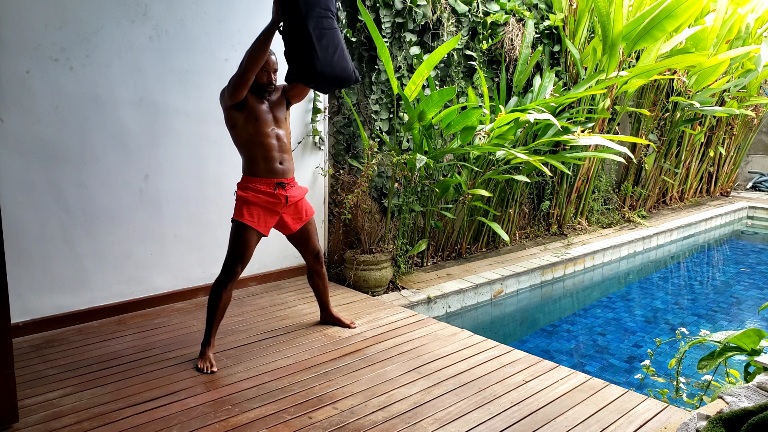
Click here to return to the Table of Contents

Where to find the Day’s Workout Routine for HIIT Days
With the advent of Crossfit and workouts of the day (WODs) posted daily, it has never been easier to find the day’s workout for HIIT days, to train the entire body, train cardio, and train strength at the same time.
If you don’t have a workout in mind, or just want to spice things up, these are the best sites and resources I’ve found for your day’s workout:
- Crossfit Main Site Workout
- Crossfit Invictus
- Crossfit Girl’s Workouts
- The Crossfit Benchmark WODs
- Bodyweight Crossfit Workouts
- Travel friendly Crossfit Workouts
- Hotel Crossfit Workouts
- Crossfit Hero WODs
Planning Rest Days and Recovery Time the Right Way: Plan one day of rest, but listen to your body and consider more
No matter what workout split you choose, you should have at least 1 rest and recovery day per week, ideally 2 days, with a moderate-intensity workout program.
Additionally, for high-intensity movements, allow 48 hours of rest between sessions for a full recovery.
Ultimately though, listen to your body. If you are feeling fatigued, at the very least, turn down the intensity and focus on proper form, but ideally, take the day off or focus on active recovery.
If you have multiple days wherein your strength and performance is below the norm, consider the possibility that you are overtraining, and instead swap out a training day with a mobility and recovery day.
Make time for mobility, stretching, and “active recovery” for better performance, less pain, and a bulletproof body into old age
As we age, many athletes complain about their bodies due to aches, pains, usage injuries, or even simple injuries that occur in everyday movements or training.
Many times, these pains and injuries occur due to a lack of range of motion in a joint, compared to a normal, healthy range of motion. This lack of range of motion creates compensation (from other muscle groups), pain, usage injuries, and more.
We can avoid the frustration that comes with our bodies, joints, and muscles not working properly by performing maintenance – moving our limbs and joints through their full range of mobility without resistance, with resistance, and even beyond their range (via “stretching”) to increase or range of motion and mobility.
As a favor to yourself, add mobility work to your workout days or rest days such that you target, stretch, and mobilize trouble spots once weekly and all other joints and body parts once every two weeks. Additionally, consider adding mobility for body parts on the same day they are trained. For instance, mobilize shoulders and chest on your pushing upper body days
As always, I highly recommend Kelly Starret’s old Mobility WOD** videos as a resource for mobility training, along with his current project, The Ready State**. Pick one of those workouts to do daily and you’ll be more than covered.
Isolation exercises vs. Compound exercises: Compound exercises save time, and Build more functional strength & muscle faster than isolation exercises
Though isolation exercises are a gym favorite, in all of these workout splits we skip isolation exercises in favor of compound movements.
For example, biceps curls and triceps extensions are isolation movements, while overhead presses, pull-ups, and burpees are multi-muscle group recruiting compound exercises.
Compound exercises, which include multiple joints in each exercise, help us train more of the body in a single exercise – saving us time – and develop the body parts’ respective strength and muscle tissues in a balanced, natural, functional way. This happens because each body part contributes to a portion of the work being applied relative to its intended size in the body, and undergoes stress, stimulation, and growth in proportion as well.
Additionally, compound exercises naturally burn more calories and stimulate more muscle growth, due to the amount of work being done and subsequent hormone responses.
Bottom line: Aim for compound exercises in your home workout, to get more work done and get more results quicker
Why training with a focus on movements over focusing on different muscle groups is a better approach for home workouts: Training movements is more feasible with less equipment and leads to a more functional body
Just as focusing on compound, multi-joint movements is more effective, efficient, and natural than doing isolation movements, focusing on “movements” instead of muscle groups is an equally efficient and natural way to train
Though all of our movements could be broken down into individual exercises – such as the muscle up can be broken into pull ups and dips – the aggregate movement allows us to perform more work at a higher intensity, training the muscle fibers and triggering more muscle growth with less time invested.
Also, just like calisthenics, these compound movements can be progressed through. Just like the muscle up can be done scaled using a suspension trainer with feet on the ground, or using a resistance band overhead, any movement can be scaled and performed – developing the body in an efficient natural way.
So, instead of focusing on back day and chest day, think about the full movements of pushing and pulling from your upper body in all planes, and the movements of flexion and extension with the legs and hips in a single leg day.
How we increase intensity without heavy weights: Aim for more time under tension, reduce rest periods, and use progressions to boost the intensity
If muscle growth is your primary goal then the first hurdle you will overcome in your home gym is a lack of varied weights.
At the gym you have a row of dumbbells, likely sized in 5lb increment steps up, from 5lbs to 150lbs+. At home, you may have a single kettlebell, and a couple dumbbells, but limited weight overall.
To compensate for using lighter weights in our muscle building workouts, but still maxing out intensity, you can do the following
Increase time under tension
- Use intentional, slower repetitions
- Use static holds within the exercises and range of motion
- Go to failure on sets – regardless of the number of reps, ensuring you maintain good form.
Reduce rest time
The standard rest time between sets for hypertrophy is 30 seconds to 1 minute, instead, drop down to 15 seconds (or less) to increase the burn with what you have
Consider supersets
Pair exercises with opposing muscle groups – think push-ups and horizontal rows – and perform these movements back to back with minimal rest. This approach does allow your muscles to recover enough for the next set, but cranks up the intensity and potential of your workout dramatically
Use Calisthenics Progressions
Standard gymnastics movements, such as the planche, muscle up, and handstand push up are far more taxing than their weight gym counterpart moves. To increase the intensity of your workout, learn to use scaled advanced gymnastics and calisthenics movements by using progression exercises in your workouts.
Click here to return to the Table of Contents



Frequently Asked Questions about Planning Workout Splits for Home Fitness
- Is it better to do full-body workouts or splits at home?
- What is a good 5-day workout split?
- Is the split workout approach effective?
- How much rest do you need?
- What about smaller muscle groups?
- What about cardio?
Click here to return to the Table of Contents

Is it better to do full-body workouts or splits at home?
If your goal is increased strength and muscle, workout splits will be the best path, to create enough intensity, and stimulus for growth, while allowing a sufficient rest period.
What is a good 5-day workout split?
- Day 1: Upper body pushing and pulling
- Day 2: Lower Body Strength
- Day 3: Upper pulling: Upper body pushing and pulling
- Day 4: Lower Body Strength
- Day 5: Core, Arms, Full body HIIT
- Day 6: Rest and Mobilize Upper Body
- Day 7: Rest and Mobilize Lower Body
Is the split workout approach effective?
Yes, the split workout approach is effective if your goals are increased muscle mass and strength. This is because stimulating growth and muscle mass in a muscle group requires a balance of intensity and recovery while the body still benefits from moving every day – even if the target muscle group isn’t used in the workout.
How much rest do you need?
After an intense workout, muscle groups generally recover after 48 hours of complete rest and proper nutrition.
What about smaller muscle groups?
Smaller muscle groups benefit heavily from ancillary mobility training, and should additionally be monitored for undertraining and imbalance within high-intensity exercise programs.
What about cardio?
Any training that maintains an elevated heart rate in the training zone for one’s specific age group for at least 20 minutes is a satisfactory cardio training session, whether it is HIIT, Crossfit, running, swimming, cycling, etc. According to the American Heart Association, each person should strive for at least 75 minutes per week of high intensity activity or 150 minutes per week of moderate intensity activity.
The day’s workout counts to the weekly movement target as long as you stay moving the entire time.
Click here to return to the Table of Contents

More Great Articles to Help You Get Fit



ABOUT THE AUTHOR
Carlos is a nomad, slow traveler, and writer dedicated to helping others live abroad and travel better by using his 7+ years of experience living abroad and background as a management consultant and financial advisor to help other nomad and expats plot better paths for an international lifestyle. Click here to learn more about Carlos's story.
